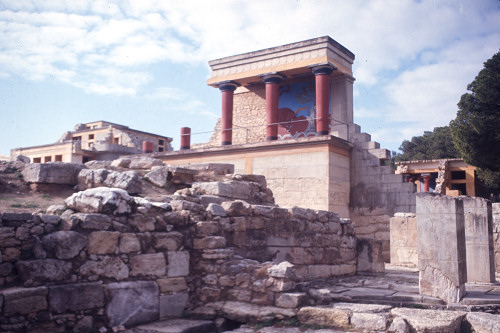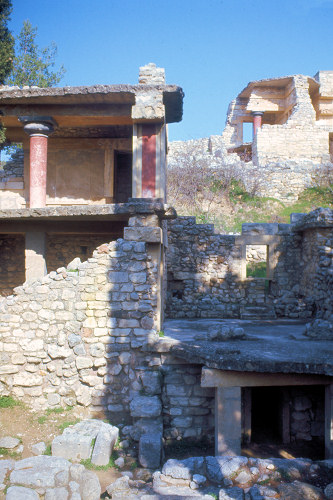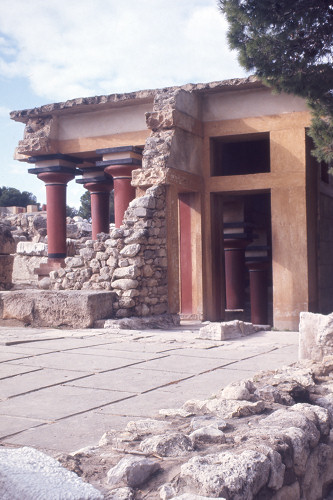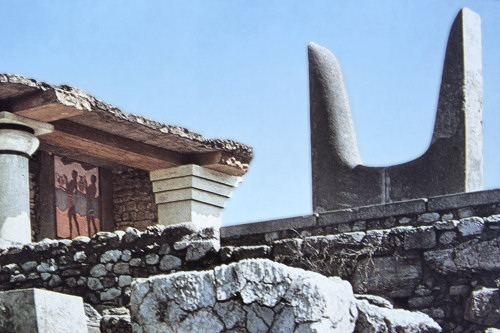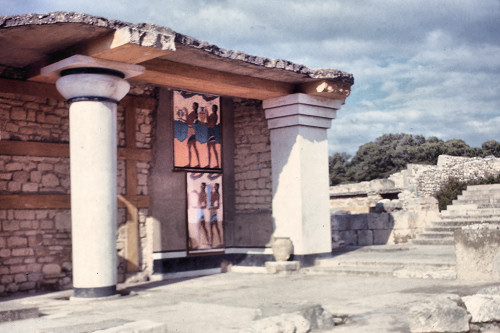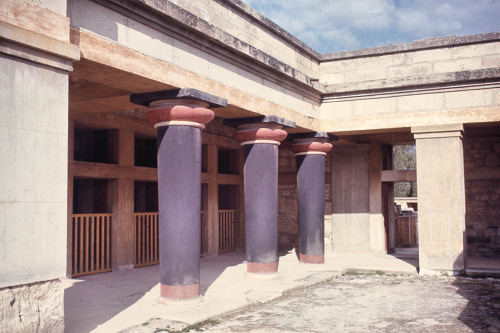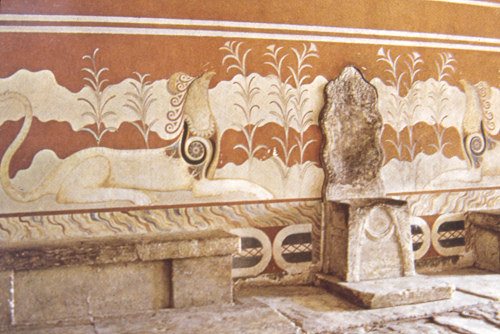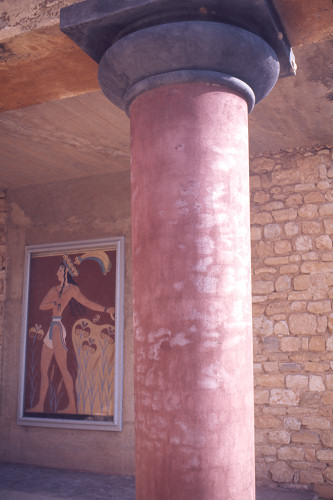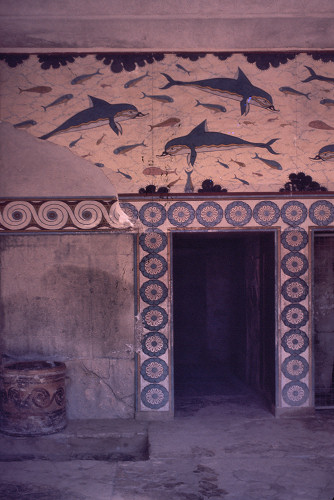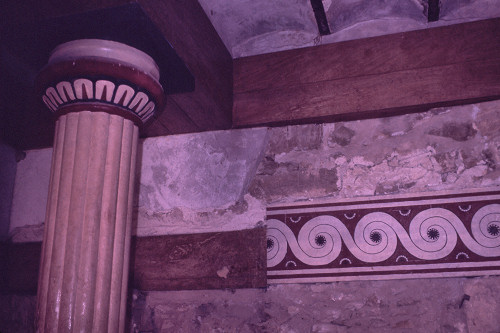Ancient Phoenicians founded
the island of Crete and built the capital town of Knossos over 4000
years ago. The island offered fertile lands well suited for the growth
of grape and olive crops and Crete developed into a land of wine and
olive oil, essential commodities to the ancient people of the Aegean
and Mediterranean. Its culture grew and became the wealthy cultural
headquarters for the earliest literate civilization which would come
to be called the Minoans. The Minoan citizens of Knossos enjoyed
opulent lifestyles while Crete became a commercial center and obtained
a level of an economic golden age.
Greek mythology immortalized Crete and
Knossos with its legends. According to the Greeks, Mount Ida which is
on Crete was the location where Rhea, the Earth Mother, gave birth to
Zeus. He was fed by nature a diet of honey and goatís milk, was
tended by a group of nymphs, and was guarded by an army of youths
against his father, Cronis, whose reign was threatened by Zeusí
existence. Zeus fathered a son, Minos, who became the King of Knossos,
Crete, and the rest of Aegean.
King Minos built his palace in the city
of Knossos, and had a son, Androgeus. Androgeus, according to the
myth, was a strong, athletic youth. He was sent to represent Crete in
the Athenian games and was successful in winning many events. The King
of Athens murdered Androgeus out of jealousy. When Minos heard about
the death of his son, he was enraged and he deployed the mighty Cretan
fleet.
The fleet took Athens and instead of
destroying the city, Minos decreed that every nine years Athens was
obligated to send seven young men and seven virgin women. King Minos
threw them into a labyrinth where they were sacrificed to his fierce,
bovine monster, the Minotaur. Theseus, the Athenian Kingís son,
volunteered to be one of the seven sacrificial young men with the
intention of killing the Minotaur and end the suffering of Athens. If
he succeeded in his mission, he told his father that he would raise
white sails instead of the black sails.
Theseus arrived at the palace of the
Cretan King, and with the help of Minosí daughter, Ariadne, who fell
in love with Theseus, he was able to kill the Minotaur. In returning
home, Theseus, in his excitement, forgot to change the sails on the
ship from black to white. The King of Athens saw the black sails.
Thinking that his sonís plan failed and that Theseus was dead, the
king flung himself into the sea and died.
Archaeologist Heinrich
Schliemann, who discovered Troy, was fully intending to excavate
Knossos until his death. Arthur Evans, a well educated Englishman,
succeeded in revealing the Minoan culture on Crete with the assistance
of Duncan McKenzie, an experienced excavator. When Evans began digging
in 1900, the remains of the walls lay close to the surface. After a
few weeks, Evans discovered the remains of buildings spanning over an
area of 8,480 square feet.
The remains of the palace itself
covered five and a half acres. The palace was originally built in 2000
BC. It was rebuilt and enlarged in 1700 BC after a massive earthquake
and again rebuilt and modified in 1500 BC after a devastating fire. At
its most modern, the palace provided drainage sumps, luxurious
bathrooms, ventilation systems, ground-water conduits and waste
chutes.
Evans unearthed other wonders of
Knossos as well. Thousands of artifacts found helped identify the
various rooms and their functions. Kitchens, residences, storerooms,
bathrooms, workshops, and ceremonial rooms were discovered. The
artifacts included pottery, stone and metal work and other lovely,
colorful works of art, revealing the level of artistry the Minoan
people possessed.
In one of the old storerooms that Evans
discovered in the palace at Knossos, stood rows of huge, vase-like
jars that once contained oil. The oil vessels were ornamented in rich,
elegant detail. Evans measured the volume of each of the containers
and calculated that the inventory of the storeroom contained around
19,000 gallons of oil. Some pottery had a foreign origin, particularly
Egyptian. The Egyptian pottery were from particular periods in
Egyptian history and helped date three periods of Minoan history, an
Early Minoan Period from 3000 to 2000 BC, a Middle Minoan Period,
proceeding until 1600 BC and a Late Minoan Period lasting until around
1250 BC.
Evans also found stone and metal
artifacts. Some of his findings predated the earliest period of Minoan
history, dating back to Neolithic times. Originally Evans believed the
artifacts were ten thousand years old, but later experts dated these
stone artifacts to be five thousand years old. Many bronze objects
that were used daily in ancient Knossos were also found. Some bronze
statues and figurines were discovered in conjunction with ceremonial
rooms.
Other works of art recovered from
Knossos included terra cotta figurines of goddesses. Faience, though
the technique was probably imported from Egypt, was among the art
forms mastered by ancient Cretans. Evans uncovered two large faience
figurines. Both statues were wearing the typical Minoan court costume
consisting of a wide skirt with a tight, stiff bodice collar and
exposed breasts. Evans identified the larger statue as a snake goddess
or a mother goddess. The smaller one is generally accepted as her
daughter or a priestess.
The findings at Crete parallel the
Greek myth surrounding the palace at Knossos. The layout of a
courtyard in the palace hinted at a labyrinth type plan, the rooms,
corridors and halls of various storage areas built in a confusing
pattern. Its walls were made of stone fragments and columns were
erected to hold up the flat roofs. The large courtyard branched out
with the wings of various buildings surrounding it on all sides. Many
wall murals and other forms of art depicted bulls and youths
"dancing" with the bulls.
Many mysteries surround Knossos. How
much of the ancient myths are true? Evidence indicated that the
legends have a thread of truth. The palace had a courtyard designed
like a labyrinth. The bull dancing indicated by the art works could
possibly be youths sacrificed to a bull. Experts suggest that Theseus
represented an army that conquered Crete.
Knossos harbored another mystery. How
was the civilization destroyed? The destruction is apparent but its
cause is not. Evans believed that Knossos was destroyed by a powerful
seismic event. However, most experts have since decided that Crete was
invaded and destroyed. The debate continued as to which group of
people was responsible for the massive destruction. Many experts
believe that is was either the Dorians, the Achaens, or the Mycenaeans.
The site of Knossos offered valuable
information in understanding Europeís earliest literate
civilization. Evansí work enlightened the history of not only
Knossos, but also the surrounding cultures. However, the information
had brought even more questions. The answers must be found by a closer
examination of the site of Knossos. Otherwise, they are doomed to
remain a mystery.
http://emuseum.mnsu.edu/archaeology/sites/europe/knossos.html
|
